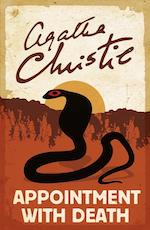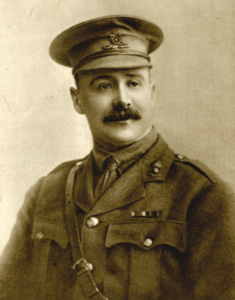
Poirot Score: 60
Appointment with Death
☆☆☆
Reasons for the Poirot Score
There is one decent clue that has to be put together from two pieces of information, but many alternative solutions are equally plausible. There is some interesting discussion about the ethical issues of letting off a murderer if the victim were wicked. This is an entertaining read, as always, but as a whodunnit it is one of Christie’s poorer Poirot mysteries. We have however marked it up a little because Christie was trying to develop ‘psychological’ clues based on the character of the victim. A noble failure!
Click here for main review (spoilers ahead)
Trivia
Dedication
To Richard and Myra Mallock to remind them of their journey to Petra
Christie grew up close to Cockington Court where she enjoyed amateur dramatics with members of the Court’s owners, the Mallock family [See Why didn’t they ask Evans trivia]. The Mallock’s had been silversmiths in the seventeenth century and fortunate to be on the winning side in the Civil War which is how they came to own the property. They remained owners until 1933. In 1875 Richard Mallock inherited the property when his elder brother died. Richard became Conservative MP for Torquay in 1886. He married Mary Jane Dickson in 1876 and they had two children. Mary Jane died in 1878, the year of the birth of their second child, Charles Herbert. Richard married again in 1880. The Charles Herbert born in 1878 (not to be confused with his grandfather, Charles Herbert born in 1802, nor with his uncle, Charles Herbert, born in 1839) married Margaret Bazeley-White. They had a son, Richard, who was born on 24 November 1907 (and so is seventeen years Agatha Christie’s junior). He married Myra Emmy Tiarks, and so this couple is almost certainly the subject of the dedication. I imagine that Christie knew their father, who was twelve years older than she and who lived at Cockington Court after he left school (Winchester College) in 1907. Agatha Christie was a frequent visitor to Cockington Court in the years before the First World War. The photograph is of Charles Herbert Mallock, the one born in 1878, father of the Richard of the dedication, and son of the Richard who was a Member of Parliament. Charles Herbert was sadly a casualty of the War: he died in 1917 three days after being poisoned by gas near St Julien. He was awarded the DSO.
[Photo: http://www.winchestercollegeatwar.com/archive/charles-herbert-mallock/]
Dompteuse
Mrs Boynton might be old, infirm, a prey to disease, but she was not powerless …..
‘Une dompteuse,’said Dr Gerard to himself.
And he understood now what that undercurrent to the harmless family talk had been. It was hatred – a dark eddying stream of hatred.
[Part l, chapter 4]
A dompteuse is a female trainer of (wild) animals, particularly as seen in an animal circus. Dr Gerard is referring to the way in which Mrs Boynton controls – tames – her family. Although Dr Gerard is using the word in his native French, dompt and dompter are included in The Oxford English Dictionary, as rare words. Dompt is the verb – to tame, or, perhaps more appropriately in the context of Mrs Boynton, to subdue. This Dictionary provides a citation from 1673 of the noun, dompter (the male form of dompteuse): “Old Age – that great dompter and mortifier of our passions.”
Dragoman
There was a clatter of footsteps and a little party came out from the interior of the Mosque. It was the Boyntons escorted by a voluble dragoman. [Part l, chapter 6, and several references elsewhere in the novel]
The Oxford English Dictionary defines dragoman as: “An interpreter; strictly applied to a man who acts as a guide and interpreter in countries where Arabic, Turkish, or Persian is spoken”. The word came into English from the Arabic as early as the 14th century; the old Arabic word being targuman – an interpreter (and targama to translate). The ‘man’ part of the word is not related to the English word man but the word is sometimes treated as though it is, as in the plural form dragomen, although dragomans is possible and preferable.
Transjordania
Much of the action, including the murder, takes place in Transjordania where both Amman and Petra are located. Most of that country, including all the places in Transjordania mentioned in the novel, are in modern Jordan.
Prior to the First World War most of the areas of modern Syria, Lebanon, Israel, Palestinian territories, Jordan and Iraq were part of the Ottoman Empire. The Ottomans joined the German side during the War. After the defeat of Germany and the surrender of the Ottomans in 1918 control of the Ottoman territories was transferred principally to France and Britain. France controlled the northern territories (modern Syria and Lebanon) and Britain the southern territories of Palestine (roughly modern Israel, Palestinian territories and Jordan) and Mesopotamia (roughly modern Iraq). This control was enacted under the League of Nations by the legal instrument of a Mandate. The purpose of Mandates was to administer the former Ottoman territories “until such time as they are able to stand alone”. The Mandate for Palestine first removed the Ottomans from any control and then enabled the establishment of a local government with very significant control by Britain and with some protection of minorities within the area. By 1922 the part of Palestine east of the river Jordan had effectively become a separate state – Transjordan, or Transjordania – from the part to the West – Palestine. In the part to the west, under the Mandate, Jewish immigration was encouraged with a potential Jewish National Home being envisaged within the territory. This aspect of the Mandate did not apply to the part to the east. By 1923 Britain recognised Transjordan an independent state ruled by Abdullah. The British, however, had control over its foreign relations, significant financial control, operated much civil administration (hence Colonel Carbury acting as coroner) and had a military presence. In 1946 Transjordan became a kingdom entirely separate from British control and changed its name from the Emirate of Transjordan to The Hashemite Kingdom of Jordan (or Jordan, for short).
King Abdullah l
Emir of Transjordan from 1921-1946; King of Jordan from 1946 – 1951
[http://en.wikipedia.org/wiki/Abdullah_I_of_Jordan]




